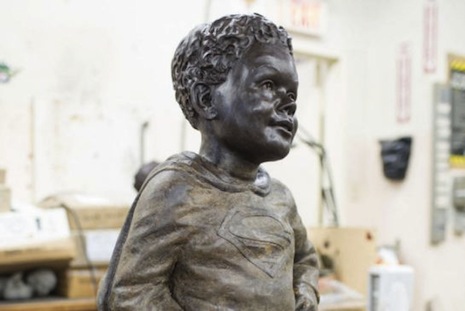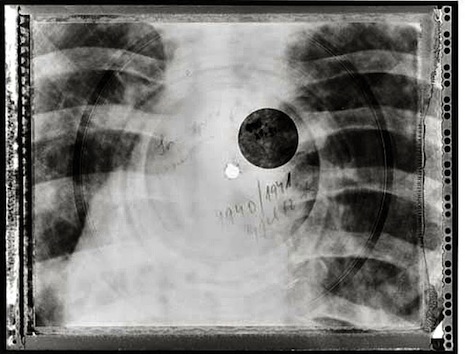
Nothing represents the Sex Pistols’ ability to push buttons as well as the choice of the word “Bollocks” to appear in the title of their first record in 1977. Unquestionably vulgar in an in-your-face way, the word was nevertheless not obviously obscene, or “indecent,” to employ the legal terminology used at the time. It was offensive enough that Her Majesty’s Government sought to suppress the display of the word in public—but not offensive enough for that position to carry the day in court. “Bollocks” clearly has some relationship to the word “Balls,” but it’s not a 1:1 relationship—it’s a little like the word “freaking” to substitute for “fucking,” but better and more vivid. Bollocks to that! “Bullshit” would be an a close synonym for American English. It’s the perfectly rude Sex Pistols word.
On Saturday, November 5, 1977, a policewoman named Julie Dawn Storey spotted the Never Mind The Bollocks display in the window of the Virgin Records store in Nottingham. She went inside, confiscated a couple of albums, and informed shop manager Christopher Seale that the appearance of the word “Bollocks” in the display violated the 1899 Indecent Advertising Act. Then she arrested him. For the couple of weeks before the trial, nobody could risk the legality of the album’s name—shop owners were forced to sell the album under the table, and a Pistols’ expensive ad campaign appeared to go to waste because no publications would dare to run it. Naturally all of this had the effect of adding to the Pistols’ reputation as the most controversial band in Britain.

Christopher Seale and the Sex Pistols’ immortal album art
On November 24, 1977, the court convened to rule on the fate of the shop owner, Christopher Seale, and Virgin Records. Defending the Sex Pistols was a fusty-looking chap who didn’t look like he belonged on the same continent as the Sex Pistols, much less the same courtroom. His name was John Mortimer, and by the time of his death at the age of 85 in 2009, his status as one of the most beloved attorneys and novelists in British history would be rock-solid.
Before the “Bollocks” trial, Mortimer’s primary claim to fame as a lawyer was his work on obscenity cases. He successfully defended the publication in Britain of Hubert Selby Jr.‘s Last Exit in Brooklyn in 1968, and three years later lost a similar case involving the scandalous Danish book The Little Red Schoolbook. In 1976, he defended Gay News editor Denis Lemon for the crime of publishing James Kirkup’s poem “The Love that Dares to Speak its Name” against charges of blasphemous libel; Lemon lost the case but it was overturned on appeal.
Although he would achieve much greater fame later, Mortimer had already been a writer of fiction for some years, which may partially explain his interest in obscenity cases. In the 1960s he had written A Voyage Round My Father, an autobiographical play about his relationship with his blind father (also a barrister)—it was later made into a TV movie with Laurence Olivier and Alan Bates. With his wife, Mortimer also wrote the script for Otto Preminger’s 1965 movie Bunny Lake Is Missing. In 1975 Mortimer began his lengthy series of bestselling comic novels revolving around Horace Rumpole.
In 1978, just a year after the Pistols trial, Thames Television launched Rumpole of the Bailey, its immensely popular series about a rumpled—if you will—and principled barrister who defends his clients against the weight of the Crown with everything he’s got. Rumpole was portrayed by Leo McKern, who became synonymous with the role—although DM readers might know him better as the heavy in the Beatles movie Help!.

Mortimer and McKern, in costume as Rumpole
As odd a fit as it may seem, Mortimer obviously had impeccable bona fides on free speech cases, which in fact made him a perfect choice to defend the Sex Pistols in court. The website 20thcpunkarchives describes Mortimer’s strategy:
John Mortimer raised the question of why Seale was prosecuted for displaying the sleeve while the newspapers that used the same image as an illustration were not. Mortimer continued to outline the history of the term “Bollocks” tracing it back to roots in the Middle Ages. Mortimer continued by bringing in a Professor Kingsley, head of English Studies at local Nottingham University. Kingsley told the court that the term had been used from the year 1,000 to describe a small ball (or things of a similar shape) and that it has appeared in Medieval Bibles, veterinary books and literature through the ages. He also revealed (not surprisingly) that it also served as part of place names throughout the UK. Eyebrows were raised when Kingsley said that the term had been used to describe the clergy of the previous century. In that connotation it was used in a similar fashion as the word rubbish and used to describe a clergyman that spoke nonsense. The defense continued to intimate that perhaps the prosecution was not interested in decency of the word in question but instead were waging war against the band themselves. After making the case clear, the judiciary deliberated for twenty minutes and felt compelled to dismiss all charges against Seale. The Sex Pistols’ cover was ruled as “decent” and set a precedent that would protect other shop owners who displayed the cover.
Johnny Rotten had attended the trial wearing a safari hat. As he exited the courtroom, a reporter solicited his comment—I remember hearing about this line when I was in high school, and it tickles me now just as much as it did then. Rotten was quoted as saying:
“Great! Bollocks is legal. Bollocks! Bollocks! Bollocks!”
Posted by Martin Schneider
|
07.31.2014
03:08 pm
|




























